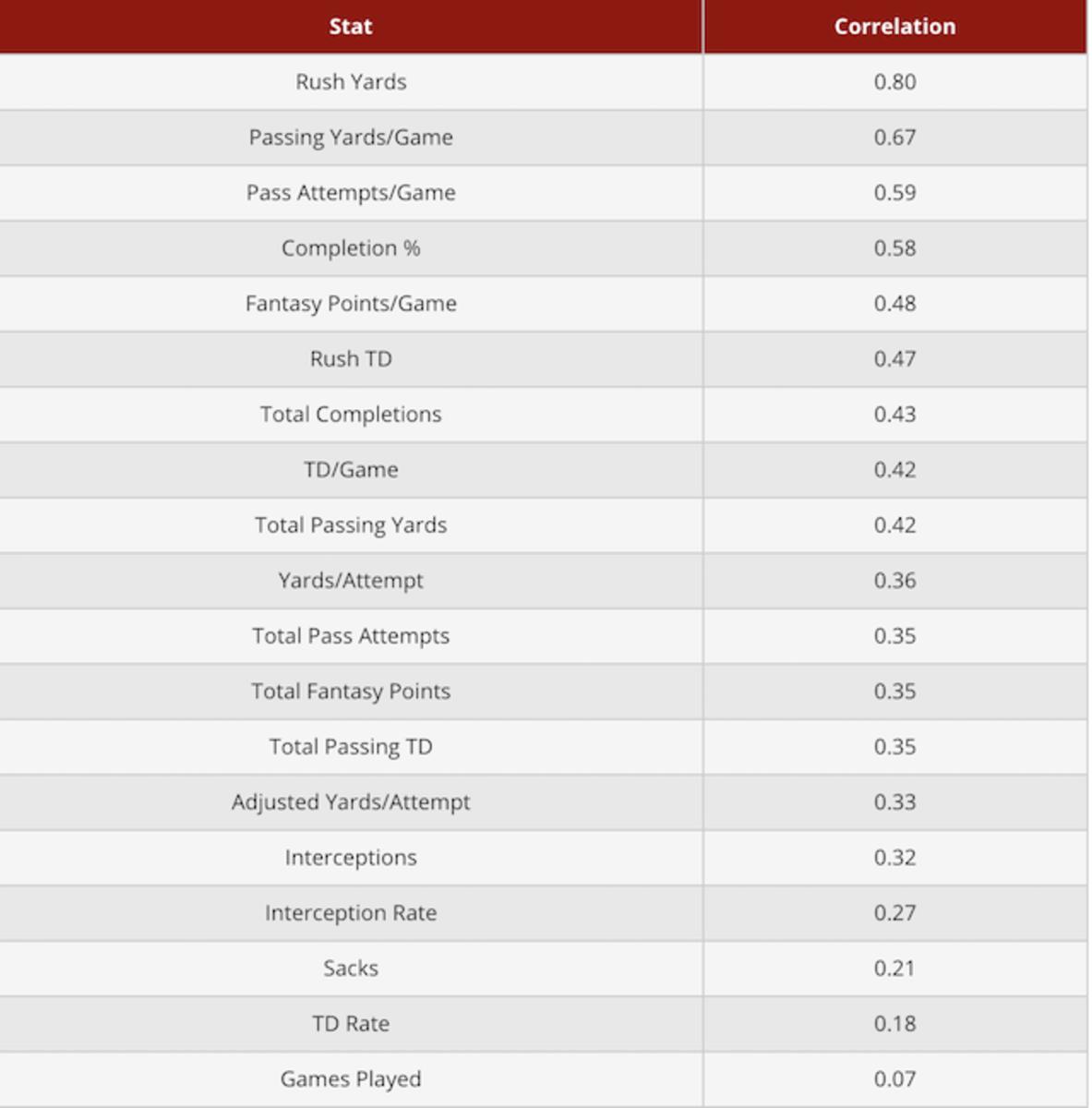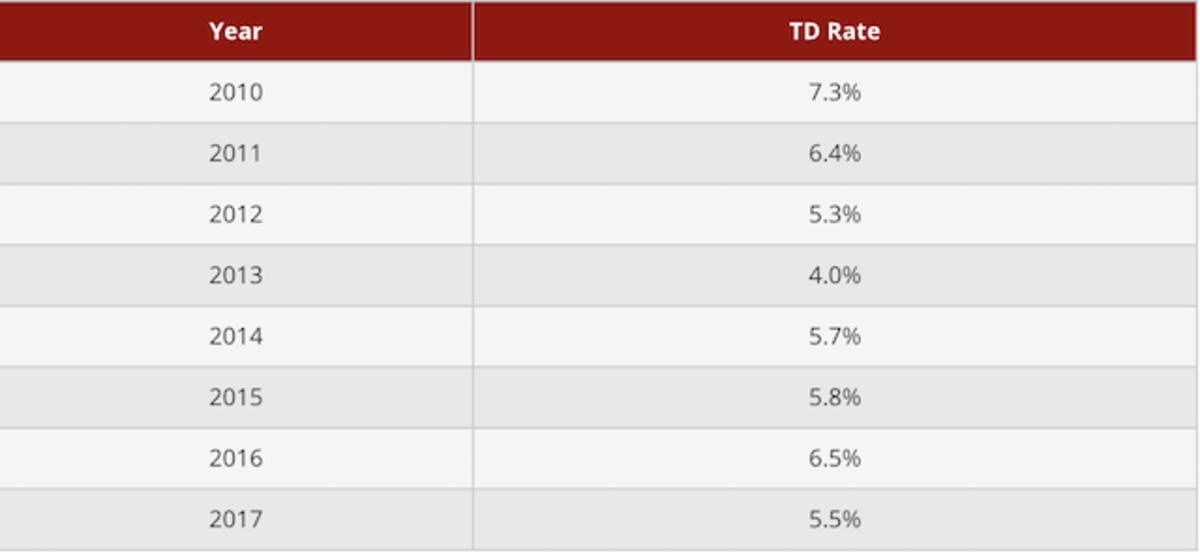The Most Predictable Quarterback Stats

It can be tempting to simply look at the previous season as a sign of things to come and build expectations accordingly. This can be a valuable exercise, but if the analysis is predicated on the wrong stats, the effort will be all for naught.
This study will shed some light on which commonly referenced stats are the most reliable indicators of future quarterback performance, as well as which commonly referenced stats might be misleading.

The Methodology
Because so many things can change in the NFL from year to year, this study reaches back to 2010 and considers only quarterbacks who remained on the same team in consecutive years and attempted at least 200 passes in both years. In a study that can be inherently sensitive to outliers, eliminating something as drastic as a team change allows us to limit some of the noise. Although 200 pass attempts is an arbitrary cutoff, an average of at least 25 attempts per game over half of a season should be sufficient enough to put a player's performance under scrutiny.
Using this methodology, we end up with 161 instances that meet the requirements. This sample will be used to determine which of the commonly referenced stats are the most useful when trying to project a quarterback's upcoming season. We can do this by comparing how well each commonly referenced stat correlates from one season to the next.
Why One Type of Stat Has a Stronger Correlation Than the Others
The table below lists the year-to-year correlations for 19 separate quarterback stats using the methodology described above.
Year-to-Year Correlations for QBs on Same Team in Consecutive Seasons (since 2010, minimum 200 attempts)

Considering that they simply represent a player's average performance instead of his season-long totals, it’s no surprise that per-game averages best season-long totals in terms of predictability. If a quarterback misses a handful of games in one of the seasons, his season-long totals are going to quickly plummet. Given the weak correlation of games played from one year to the next, we know that’s a real possibility.
Interpreting Volume
With an understanding of why per-game stats correlate so strongly from year to year, we can take a closer look at which are the most reliable in predicting the upcoming season for a given quarterback.
Of the per-game volume stats, passing yards per game is the only one correlated strongly from year to year. All the other per-game volume numbers—pass attempts per game, fantasy points per game and touchdowns per game—have a moderate year-to-year correlation, but it's not to the point where you'd look at the previous season's numbers and feel comfortable projecting those numbers forward.
Also, note that touchdowns carry so much weight when it comes to fantasy scoring that their relatively low year-to-year correlation brings down the correlation for fantasy scoring, as well.
Fantasy Football 2018: QB Primer
The Smart Way to Use Efficiency
The relatively weak year-to-year correlations of the efficiency metrics lend some insight into why yardage is so predictable even though attempts might fluctuate from one year to the next. In fact, other than completion percentage, we cannot rely on any of the commonly referenced efficiency metrics, such as yards per attempt, adjusted yards per attempt, touchdown rate and interception rate as predictable stats based on the previous season's data.
Consider Tom Brady’s the yearly touchdown rates. Brady ranks in the top three among active quarterbacks in career touchdown rate (5.5%) and is widely regarded as one of the most efficient quarterbacks in the league:
Tom Brady Year-to-Year Touchdown Rate

Even the most efficient quarterbacks can have some huge swings in their touchdown-throwing tendencies from year to year. As such, the best application of efficiency metrics is probably to use the past season's data to gauge whether a quarterback is due for regression (be it positive or negative) to the league average, or to his individual average if there's a large enough sample.
Beware of Rushing Numbers
The fact is that most quarterbacks don’t run very much, so the expectation for most of them should be a low rushing output. This explains the very strong correlation of rushing yards from year to year. If we narrow the sample down to quarterbacks who rushed for 200 or more yards in a season, the correlation drops to 0.57. Quarterbacks who rushed for 300 or more yards in a season saw a correlation of just 0.45, while the 21 quarterbacks that rushed for 400 or more yards in a single season since 2010 saw a statistically insignificant year-to-year correlation of 0.31.
We see the same effect when looking at rushing touchdowns. If a quarterback scored at least four in a given season, the rushing touchdown correlation fell to just 0.35.
Fantasy Football 2018: Wide Receiver Primer
Bottom Line
Whether you're projecting player stats for an entire season or a single week, there are countless factors to consider outside of what happened in the past. During the offseason, though, numbers from the previous year are often the only hard data that we have at our fingertips. Those numbers can only be used as a reliable point of reference when the right factors are considered, and we now have an understanding of which stats are a sign of things to come for quarterbacks, as well as which ones might not serve as a future indicator.
